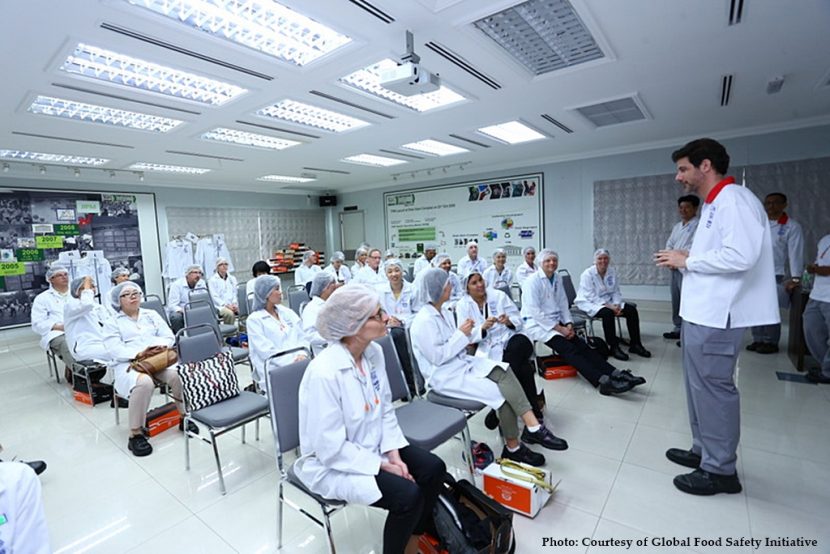Tailor Your Training to Food Safety Standards and Your Staff Needs
By Beth Driscoll
A common refrain in the food industry is “our employees are our most valuable asset,” and chances are we’ve all either heard this said at our companies, or we’ve said it ourselves. Most organizations that handle food, be it farm, processor, distributor, or grocery store recognize the importance of their employees in producing food safely. But even the best preventive control programs and HACCP plans are just words written on paper (or electrons on the screen) until employees are trained in food safety practices so they can execute your procedures correctly.
Unless you’re a small organization with a local customer base, you are probably required to meet multiple standards: customer-specific standards, government regulations, and at least one Global Food Safety Initiative certification programme (CP). Today, in an international supply chain, it’s not uncommon for a facility to have to meet half a dozen or more standards. This presents a level of complexity for your training program; how do you make sure that all your employees are trained to ensure compliance to all these standards?
It’s not uncommon for a facility to have to meet half a dozen or more standards
Food Safety Compliance Training
It’s important to start with a compliance risk assessment by making a list that includes:
- Government regulations – List all the countries your products are exported to, and all the provinces or states your products are sold in.
- GFSI CPs – List any CPs you are certified to, and any that you might certify to in the upcoming year.
- Customer standards – List all your customers and identify any requirements they have that are outside government regulations and CPs.
Training for compliance requires knowing the nuances of each standard, so read each one carefully. All have common ground, e.g. each employee must be trained to good manufacturing practices (GMPs). But there could be standard-specific requirements that could result in a non-conformance/non-compliance (NC/NC) rating for your facility. A matrix here would be valuable.
Next, look at your NC/NCs and customer complaints and examine each one’s root cause. Here you must be candid with yourself: which ones were the result of true mistakes and which ones were the result of inadequate resources, e.g. lack of training or insufficient equipment?
Finally, consider risk-assessment information when you develop your training program. Pay particular attention to any unique requirements, making sure you don’t overlook these clauses.
Effective Training Programs for Employees
Once you know what training is required, develop a training plan to determine how your employees should be trained. Employees rarely set out to make a mistake, but mistakes do happen, and shortcuts are taken. There are many reasons for this, but one of the most common is that your employees may not have a good grasp of the training language. Consider how many of your employees have English as a first language. Most procedures are written in high-level English, designed for management, quality assurance, and the auditor/inspector, but this isn’t likely the level of English your employees understand.
Training should be done, where possible, in the language most of your employees speak. This may not be practical, so see if there is a trusted employee who is fluent in both languages. Training sessions should be translated by this person. Yes, this takes more time and training resources, but it’s also more effective and will help to ensure compliance. Follow this with one-on-one coaching in the primary language the employees speak and, where possible, have procedures written in this language.
It’s also important to consider that employees who speak English-as-a-first-language have sufficient literacy to understand a written procedure. Low levels of literacy are not uncommon in the manufacturing sector and it’s your responsibility to recognize when an employee might not be comprehending what’s written on the page.
Your ability to comply with both government regulations and private standards depends largely on your employees. Understanding both the program requirements and the training needs of your staff will help you meet compliance throughout the international supply chain.
About the Author
Beth Driscoll, PhD, CPHI(C), CHA, PMP is an independent food safety professional with Driscoll Food Safety Inc. With more than 15 years’ experience in the food industry, she specializes in the food retail, food service, food ingredient, and packaging manufacturing, and food distribution sectors. She is both a Public Health Inspector with the Canadian Institute of Public Health Inspectors and a Certified HACCP Auditor with the American Society for Quality.

-
 FeaturedRisk management
The Cost of a Breach: What a Cyberattack Could Mean for Food Safety Recalls
FeaturedRisk management
The Cost of a Breach: What a Cyberattack Could Mean for Food Safety Recalls
-
 FeaturedRisk management
Securing the Food Chain: How ISO/IEC 27001 Strengthens Cybersecurity
FeaturedRisk management
Securing the Food Chain: How ISO/IEC 27001 Strengthens Cybersecurity
-
 FeaturedRisk management
Revolutionizing Food Safety Training: Breaking Out of the “Check-the-Box” Mentality
FeaturedRisk management
Revolutionizing Food Safety Training: Breaking Out of the “Check-the-Box” Mentality
-
 GFSI Standards
GFSI 2025: Building Trust, Tech-Forward Solutions, and Global Unity in Food Safety
GFSI Standards
GFSI 2025: Building Trust, Tech-Forward Solutions, and Global Unity in Food Safety
-
 FeaturedFood Safety
Integrated Pest Management: Strategies to Protect Your Brand’s Reputation
FeaturedFood Safety
Integrated Pest Management: Strategies to Protect Your Brand’s Reputation
-
 FeaturedFood Safety Culture & Training
No Open Door Policy: Challenges That Impact Pest Control in Food Processing Plants
FeaturedFood Safety Culture & Training
No Open Door Policy: Challenges That Impact Pest Control in Food Processing Plants




